2018年高考英语二轮复习第一部分阅读理解篇专题1阅读理解第4讲主旨大意类练案
- 格式:doc
- 大小:473.52 KB
- 文档页数:17
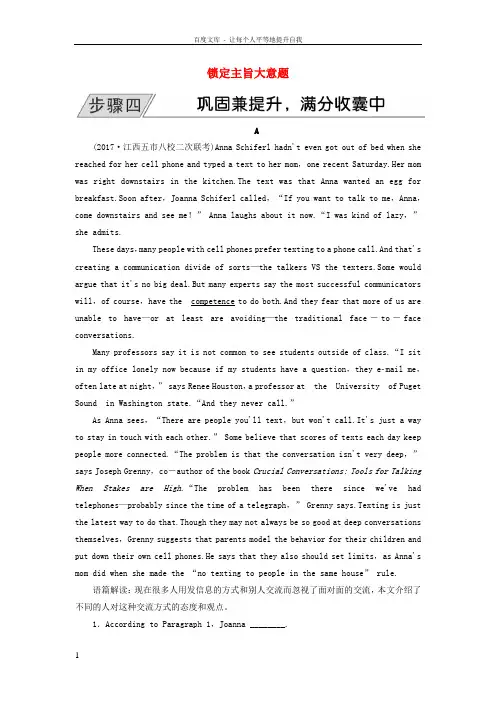
锁定主旨大意题A(2017·江西五市八校二次联考)Anna Schiferl hadn't even got out of bed when she reached for her cell phone and typed a text to her mom,one recent Saturday.Her mom was right downstairs in the kitchen.The text was that Anna wanted an egg for breakfast.Soon after,Joanna Schiferl called,“If you want to talk to me,Anna,come downstairs and see me!” Anna laughs about it now.“I was kind of lazy,” she admits.These days,many people with cell phones prefer texting to a phone call.And that's creating a communication divide of sorts—the talkers VS the texters.Some would argue that it's no big deal.But many experts say the most successful communicators will,of course,have the competence to do both.And they fear that more of us are unable to have—or at least are avoiding—the traditional face-to-face conversations.Many professors say it is not common to see students outside of class.“I sit in my office lonely now because if my students have a question,they email me,often late at night,” says Renee Houston,a professor at the University of Puget Sound in Washington state.“And they never call.”As Anna sees,“There are people you'll text,but won't call.It's just a way to stay in touch with each other.” Some believe that scores of texts each day keep people more connected.“The problem is that the conversation isn't very deep,” says Joseph Grenny,co-author of the book Crucial Conversations: Tools for Talking When Stakes are High.“The problem has been there since we've had telephones—probably since the time of a telegraph,” G renny says.Texting is just the latest way to do that.Though they may not always be so good at deep conversations themselves,Grenny suggests that parents model the behavior for their children and put down their own cell phones.He says that they also should set limits,as Anna's mom did when she made the “no texting to people in the same house” rule.语篇解读:现在很多人用发信息的方式和别人交流而忽视了面对面的交流,本文介绍了不同的人对这种交流方式的态度和观点。
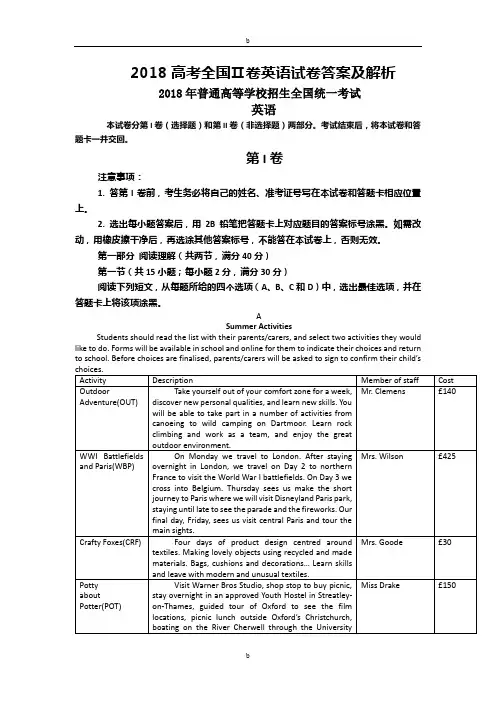
2018高考全国Ⅱ卷英语试卷答案及解析2018年普通高等学校招生全国统一考试英语本试卷分第I卷(选择题)和第II卷(非选择题)两部分。
考试结束后,将本试卷和答题卡一并交回。
第I卷注意事项:1. 答第I卷前,考生务必将自己的姓名、准考证号写在本试卷和答题卡相应位置上。
2. 选出每小题答案后,用2B铅笔把答题卡上对应题目的答案标号涂黑。
如需改动,用橡皮擦干净后,再选涂其他答案标号,不能答在本试卷上,否则无效。
第一部分阅读理解(共两节,满分40分)第一节(共15小题;每小题2分,满分30分)阅读下列短文,从每题所给的四个选项(A、B、C和D)中,选出最佳选项,并在答题卡上将该项涂黑。
ASummer ActivitiesStudents should read the list with their parents/carers, and select two activities they would like to do. Forms will be available in school and online for them to indicate their choices and return to school. Before choices are finalised, parents/carers will be asked to sign to confirm their21. Which activity will you choose if you want to go camping?A. OUTB. WBPC. CRFD. POT22. What will the students do on Tuesday with Mrs Wilson?A. Travel to London.B. See a parade and fireworks.C. Tour central Paris.D. Visit the WWI battlefields.23. How long does Potty about Potter last?A. Two days.B. Four days.C. Five days.D. One week.文体:应用文主题:文章主要提供给了孩子们四种不同类型的夏日活动以及相关具体信息。

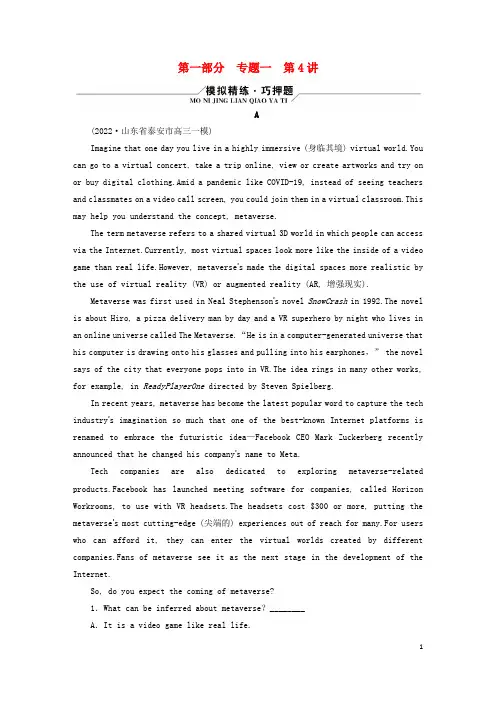
第一部分专题一第4讲A(2022·山东省泰安市高三一模)Imagine that one day you live in a highly immersive (身临其境) virtual world.You can go to a virtual concert, take a trip online, view or create artworks and try on or buy digital clothing.Amid a pandemic like COVID-19, instead of seeing teachers and classmates on a video call screen, you could join them in a virtual classroom.This may help you understand the concept, metaverse.The term metaverse refers to a shared virtual 3D world in which people can access via the Internet.Currently, most virtual spaces look more like the inside of a video game than real life.However, metaverseʼs made the digital spaces more realistic by the use of virtual reality (VR) or augmented reality (AR, 增强现实).Metaverse was first used in Neal Stephensonʼs novel SnowCrash in 1992.The novel is about Hiro, a pizza delivery man by day and a VR superhero by night who lives in an online universe called The Metaverse.“He is in a computer-generated universe that his computer is drawing onto his glasses and pulling into his earphones,” the novel says of the city that everyone pops into in VR.The idea rings in many other works, for example, in ReadyPlayerOne directed by Steven Spielberg.In recent years, metaverse has become the latest popular word to capture the tech industryʼs imagination so much that one of the best-known Internet platforms is renamed to embrace the futuristic idea—Facebook CEO Mark Zuckerberg recently announced that he changed his companyʼs name to Meta.Tech companies are also dedicated to exploring metaverse-related products.Facebook has launched meeting software for companies, called Horizon Workrooms, to use with VR headsets.The headsets cost $300 or more, putting the metaverseʼs most cutting-edge (尖端的) experiences out of reach for many.For users who can afford it, they can enter the virtual worlds created by different companies.Fans of metaverse see it as the next stage in the development of the Internet.So, do you expect the coming of metaverse?1.What can be inferred about metaverse?________A.It is a video game like real life.B.It is a parallel universe imagined by scientists.C.It gives us a real life in a virtual world.D.It can protect yourself from a pandemic.2.What does Paragraph 3 mainly talk about?________A.The fiction SnowCrash.B.The origin of metaverse.C.A VR superhero.D.The film ReadyPlayerOne.3.Why did Facebook CEO use Meta as his companyʼs name?________A.Metaverse has become more popular.B.He lives in a virtual world every day.C.Facebook is the best-known Internet platform.D.He has accepted the idea of metaverse.4.What can we know from the text about VR headsets?________A.They are very cheap for most of us.B.Their users can experience a virtual world.C.Horizon Workroom donʼt need them at all.D.They will bring us into the final stage of the Internet.【语篇解读】本文是一篇说明文,介绍了什么是虚拟空间(metaverse)、其产生的由来及运用。
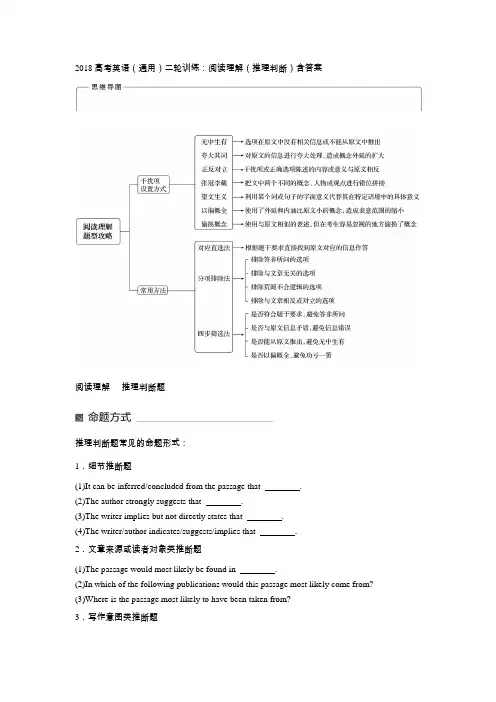
2018高考英语(通用)二轮训练:阅读理解(推理判断)含答案阅读理解----推理判断题推理判断题常见的命题形式:1.细节推断题(1)It can be inferred/concluded from the passage that .(2)The author strongly suggests that .(3)The writer implies but not directly states that .(4)The writer/author indicates/suggests/implies that .2.文章来源或读者对象类推断题(1)The passage would most likely be found in .(2)In which of the following publications would this passage most likely come from?(3)Where is the passage most likely to have been taken from?3.写作意图类推断题(1)What is the main purpose of the author in writing this passage?(2)The purpose of the passage is to get people to .(3)The writer writes the last paragraph in order to .4.态度倾向类推断题(1)The attitude of the author towards...is .(2)What’s the writer’s attitude towards...?(3)What does the author think about...?1.细节推断题要求考生根据语篇关系,推断具体细节,如时间、地点、人物关系、人物身份、事件等。
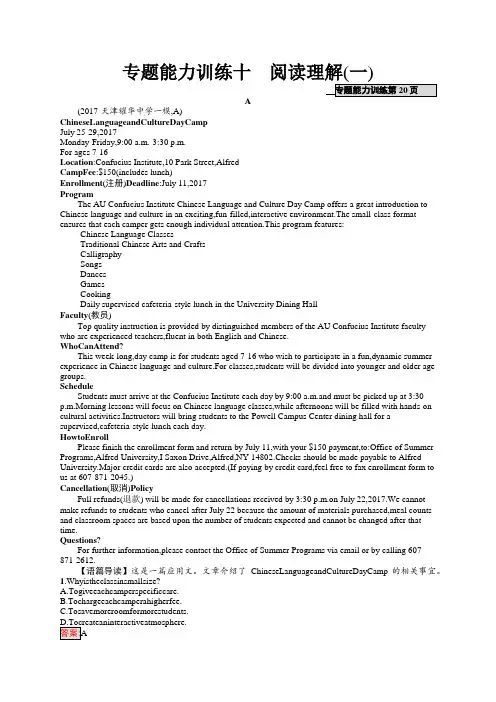
专题能力训练十阅读理解(一)A(2017·天津耀华中学一模,A)ChineseLanguageandCultureDayCampJuly 25-29,2017Monday-Friday,9:00 a.m.-3:30 p.m.For ages 7-16Location:Confucius Institute,10 Park Street,AlfredCampFee:$150(includes lunch)Enrollment(注册)Deadline:July 11,2017ProgramThe AU Confucius Institute Chinese Language and Culture Day Camp offers a great introduction to Chinese language and culture in an exciting,fun-filled,interactive environment.The small-class format ensures that each camper gets enough individual attention.This program features:·Chinese Language Classes·Traditional Chinese Arts and Crafts·Calligraphy·Songs·Dances·Games·Cooking·Daily supervised cafeteria-style lunch in the University Dining HallFaculty(教员)Top quality instruction is provided by distinguished members of the AU Confucius Institute faculty who are experienced teachers,fluent in both English and Chinese.WhoCanAttend?This week-long,day camp is for students aged 7-16 who wish to participate in a fun,dynamic summer experience in Chinese language and culture.For classes,students will be divided into younger and older age groups.ScheduleStudents must arrive at the Confucius Institute each day by 9:00 a.m.and must be picked up at 3:30p.m.Morning lessons will focus on Chinese language classes,while afternoons will be filled with hands-on cultural activities.Instructors will bring students to the Powell Campus Center dining hall for a supervised,cafeteria-style lunch each day.HowtoEnrollPlease finish the enrollment form and return by July 11,with your $150 payment,to:Office of Summer Programs,Alfred University,I Saxon Drive,Alfred,NY 14802.Checks should be made payable to Alfred University.Major credit cards are also accepted.(If paying by credit card,feel free to fax enrollment form to us at 607-871-2045.)Cancellation(取消)PolicyFull refunds(退款) will be made for cancellations received by 3:30 p.m.on July 22,2017.We cannot make refunds to students who cancel after July 22 because the amount of materials purchased,meal counts and classroom spaces are based upon the number of students expected and cannot be changed after that time.Questions?For further information,please contact the Office of Summer Programs via email or by calling 607-871-2612.【语篇导读】这是一篇应用文。
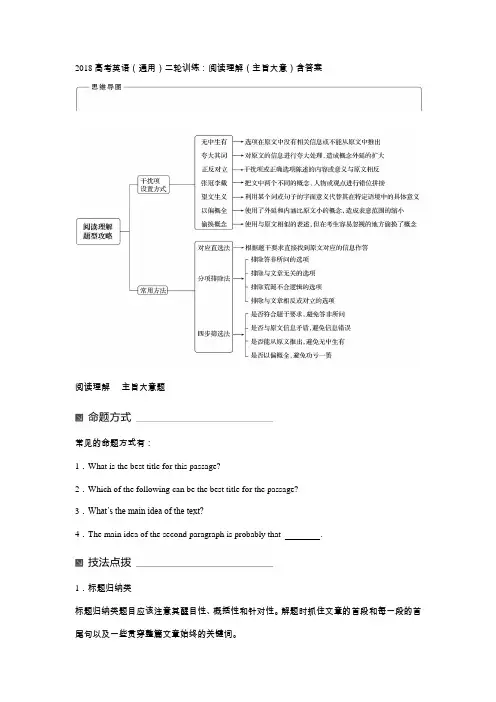
2018高考英语(通用)二轮训练:阅读理解(主旨大意)含答案阅读理解----主旨大意题常见的命题方式有:1.What is the best title for this passage?2.Which of the following can be the best title for the passage?3.What’s the main idea of the text?4.The main idea of the second paragraph is probably that .1.标题归纳类标题归纳类题目应该注意其醒目性、概括性和针对性。
解题时抓住文章的首段和每一段的首尾句以及一些贯穿整篇文章始终的关键词。
名师点津干扰项特点1.以偏概全;2.断章取义;3.主题扩大;4.张冠李戴;5.无中生有。
典题印证(2016·全国Ⅱ,C片段)Reading can be a social activity.Think of the people who belong to book groups.They choose books to read and then meet to discuss them.Now,the website turns the page on the traditional idea of a book group.Members go on the site and register the books they own and would like to share.BookCrossing provides an identification number to stick inside the book.Then the person leaves it in a public place,hoping that the book will have an adventure,traveling far and wide with each new reader who finds it.Bruce Pederson,the managing director of BookCrossing,says,“The two things that change your life are the people you meet and books you read.BookCrossing combines both.”32.What is the best title for the text?A.Online Reading:A Virtual TourB.Electronic Books:A New TrendC.A Book Group Brings Tradition BackD.A Website Links People Through Books答案 D解析标题归纳题。
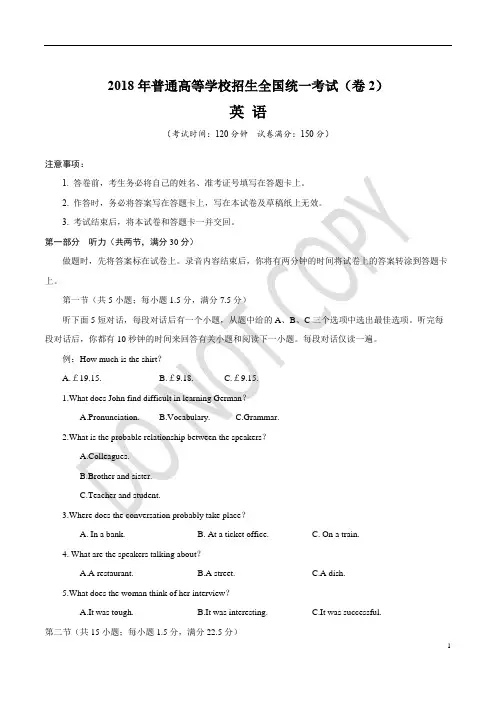
2018年普通高等学校招生全国统一考试(卷2)英语(考试时间:120分钟试卷满分:150分)注意事项:1. 答卷前,考生务必将自己的姓名、准考证号填写在答题卡上。
2. 作答时,务必将答案写在答题卡上,写在本试卷及草稿纸上无效。
3. 考试结束后,将本试卷和答题卡一并交回。
第一部分听力(共两节,满分30分)做题时,先将答案标在试卷上。
录音内容结束后,你将有两分钟的时间将试卷上的答案转涂到答题卡上。
第一节(共5小题;每小题1.5分,满分7.5分)听下面5短对话,每段对话后有一个小题,从题中给的A、B、C三个选项中选出最佳选项。
听完每段对话后,你都有10秒钟的时间来回答有关小题和阅读下一小题。
每段对话仅读一遍。
例:How much is the shirt?A.£19.15.B.£9.18.C.£9.15.1.What does John find difficult in learning German?A.Pronunciation.B.Vocabulary.C.Grammar.2.What is the probable relationship between the speakers?A.Colleagues.B.Brother and sister.C.Teacher and student.3.Where does the conversation probably take place?A. In a bank.B. At a ticket office.C. On a train.4. What are the speakers talking about?A.A restaurant.B.A street.C.A dish.5.What does the woman think of her interview?A.It was tough.B.It was interesting.C.It was successful.第二节(共15小题;每小题1.5分,满分22.5分)听下面5段对话或独白,每段对话或独白后有几个小题,从题中所给的A、B、C三个选项中选出最佳选项。

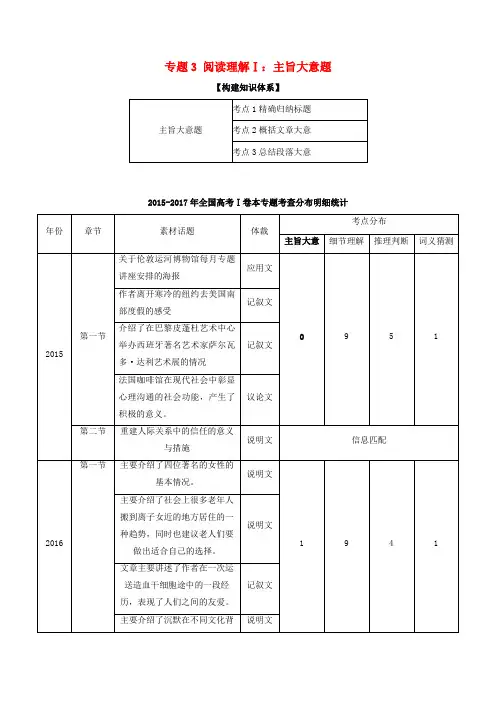
专题3 阅读理解Ⅰ:主旨大意题【构建知识体系】2015-2017年全国高考Ⅰ卷本专题考查分布明细统计2015-2017年全国高考Ⅱ卷本专题考查分布明细统计2016-2017年全国高考III卷本专题考查分布明细统计【考纲解读】【剖析全国高考真题】——预测高考命题方向[2017·全国卷Ⅰ]CSome of the world’s most famous musicians recently gathered in Paris and New Orleans to celebrate the first annual International Jazz Day. UNESCO( United Nations Educational, Scientific and Cultural Organization) recently set April 30 as a day to raise awareness of jazz music, its significance, and its potential as a unifying(联合) voice across cultures.Despite the celebrations, though, in the U.S. the jazz audience continues to shrink and grow older, and the music has failed to connect with younger generations.It’s Jason Moran’s job to help change that. As the Kennedy Center’s artistic adviser for jazz, Moran hopes to widen the audience for jazz, make the music more accessible, and preserve its history and culture.“Jazz seems like it’s not really a part of the American appetite,” Moran tells National Public Radio’s reporter Neal Conan. “What I’m hoping to accomplish is that my generation and younger start to reconsider and understand that jazz is not black and write anymore. It’s actuallycolor, and it’s actually digital.”Moran says one of the problems with jazz today is that the entertainment aspect of the music has been lost. “The music can’t be presented today the way it was in 1908 or 1958. It has to continue to move, because the way the world works is not the same,” says Moran.Last year, Moran worked on a project that arranged Fats Waller’s music for a dance party, “Just to kind of put it back in the mind that Waller is dance music as much as it is concert music,” says Moran. “For me, it’s the recontextualization. In music, where does the emotion(情感) lie? Are we, as humans, gaining any insight(感悟) on how talk about ourselves and how something as abstract as a Charlie Parker record gets us into a dialogue about our emotions and our thoughts? Sometimes we lose sight that the music has a wider context,” says Moran, “so I want to continue those dialogues. Those are the things I want to foster.”31.Which of the following can be the best title for the text?A.Exploring the Future of Jazz.B.The Rise and Fall of Jazz.C.The Story of a Jazz Musician.D.Celebrating the Jazz Day.【2017课标全国I卷】[2017·全国卷Ⅱ]CTerrafugia Inc .said Monday that its new flying car has completed its first flight, bringing the company closer to its goal of selling the flying car within the next year. The vehicle-named the Transition – has two seats wheels and wings that fold up so it can be driven like a car. The Transition, which flew at 1,400 feet for eight minutes last month, can reach around 70 miles per hour on the road and 115 in the flies using a 23-gallon tank of gas and bums 5 gallons per hourin the air. On the ground, it gets 35 miles per gallon.Around 100 people have already put down a $10,000 deposit to get a Transition when they go on sale, and those numbers will likely rise after Terrafugia introduces the Transition to the public later this week at the New York Auto Show. But don’t expect it t o show up in too many driveways. It’s expected to cost $279,000.And it won’t help if you’re stuck in traffic. The car needs a runway.Inventors have been trying to make flying cars since the 1930s, according to Robert Mann, an airline industry expert. But Mann thinks Terrafugia has come closer than anyone to making the flying car a reality. The government has already permitted the company to use special materials to make it easier for the vehicle to fly. The Transition is now going through crash tests to make sure it meets federal safety standards.Mann said Terrafugia was helped by the Federal Aviation Administration’s decision five years ago to create a separate set of standards for light sport aircraft, which are lower than those for pilots of larger planes. Terrafugia says an owner would need to pass a test andcomplete 20 hours of flying time to be able to fly the Transition,a requirement pilots would find relatively easy to meet.28. What is the first paragraph mainly about?A. The basic data of the Transition.B. The advantages of flying cars.C. The potential market for flying cars. C. The designers of the Transition.31. What is the best title for the text?A. Flying Car at Auto ShowB. The Transition’s Fist FlightC.Pilots’Dream Comi ng TrueD. Flying Car Closer to Reality31.主旨大意题。

A(2017·深圳第一次调研) Much information can be conveyed,purely through our eyes,so the expression “eyes also talk” is often heard.Can you recall any experience that further proves this statement?On a bus you may quickly glance at a stranger,but not make eye contact.If he senses that he is being stared at,he may feel uncomfortable.It is the same in daily life.If you are stared at for more than necessary,you will look at yourself up and down to see if there is anything wrong with you.If nothing goes wrong,you will feel angry about others’ staring at you that way.Eyes do convey information,right?Looking too long at someone may seem to be rude and aggressive.But things are different when it comes to staring at the opposite sex.If a man looks at a woman for more than 10 seconds and refuses to turn away his gaze (注视) ,his intentions are obvious.That is,he wishes to attract her attention,to make her understand that he is showing affection for her.However,the normal eye contact for two people engaged in conversation is that the speaker will only look at the listener from time to time,in order to make sure that the listener does pay attention to what the former is speaking,to tell him that he is attentive.If a speaker looks at you continuously when speaking,as if he tries to control you,you will feel uneasy.A poor liar usually exposes himself by looking too long at the victim,since he believes the false idea that to look straight in the eye is a sign of honest communication.In fact,continuous eye contact happens between lovers only,who will enjoy looking at each other tenderly for a long time,to show love that words cannot express.Evidently,eye contact should be done according to the relationship between two people and the specific situation.语篇解读本文介绍了“眼睛会说话”的观点,告诉我们不同场合眼神交流所代表的不同含义。
专题一阅读理解第三讲主旨大意类真题验证题组一A(2017·全国Ⅲ,D)导学号 47404011 The Intelligent Transport team at Newcastle University have turned an electric car into a mobile laboratory named “DriveLAB” in order to understand the challenges faced by older drivers and to discover where the key stress points are.Research shows that giving up driving is one of the key reasons for a fall in health and well-being among older people, leading to them becoming more isolated(隔绝) and inactive.Led by Professor Phil Blythe, the Newcastle team are developing in-vehicle technologies for older drivers which they hope could help them to continue driving into later life.These include custom-made navigation(导航) tools, night vision systems and intelligent speed ad aptations. Phil Blythe explains: “For many older people, particularly those living alone or in the country, driving is important for preserving their independence, giving them the freedom to get out and about without having to rely on others.”“But we all have to accept that as we get older our reactions slow down and this often results in people avoiding any potentially challenging driving conditions and losing confidence in their driving skills. The result is that people stop driving before they really ne ed to.”Dr Amy Guo, the leading researcher on the older driver study, explains: “The DriveLAB is helping us to understand what the key points and difficulties are for older drivers and how we might use technology to address these problems.”For example, mo st of us would expect older drivers always go slower than everyone else but surprisingly, we found that in 30mph zones they struggled to keep at a constant speed and so were more likely to break the speed limit and be at riskof getting fined. We're looking at the benefits of systems which control their speed as a way of preventing that.“We hope that our work will help with technological solutions(解决方案) to ensure that older drivers stay safer behind the wheel.”文章大意:本文是一篇科普说明文,介绍了智能交通团队建立移动实验室,研究老年人开车存在的问题和难点,帮助老年人安全驾驶。
高考高三英语二轮专题复习:阅读理解(附参考答案) ATERNANG,Mon—More than 10 000 people were made homeless in Ternang when the Sungai Mas overflowed its banks yesterday after six days of continuous heavy rain.Flooding first appeared at mid-afternoon yesterday along the river banks.People straggling higher ground were just in time to get away from the destroy of the flood.Most of the flood victims had to leave their possessions behind.The flood victims are now housed in various make-shift relief centers in the nearby town of Tu lang.“Everything possible is being done to help the unfortunate people.”A government spokesman said,“In fact,money,food and clothing have begun to come in from p ublic-spirited organizations and generous persons.”According to latest reports it is still raining heavily at Ternang.The whole town is expected to be totally covered by water.So far no casualty has been reported.56.According to the latest report .A.it had been raining for six daysB.more than 10 000 people had no place to liveC.the town had already been totally floodedD.the government tried its best to help the homeless people57.With the help of the government,the flood victims .A.were safe at higher placeB.got everything they neededC.lived comfortably in the relief centersD.were brought to Tulang within three hours58.The word “casualty”in the last sentence means .A.the house that is being builtB.the money that is given to the victimsC.the person killed or injured in an accidentD.the things lost in the floodBGlynis Davis:I first piled on the ponds when I was in the family way and I couldn’t lose them afterwards.Then I joined a slimming club.My target was 140 pounds and I lost 30 pounds in six months.I felt great and people kept saying how good I looked.But Christmas came and I started to slip back into my old eating habits.I told myself I’d lose the weight at slimming classes in the new year…but it didn’t happen.Instead of losing the pounds.I put them on.I’d lost willpower and tried to believe that the old bage of fish and chips didn’t make any difference but the scales don’t lie.Roz Juma:To be honest,I never weigh myself any more I’ve leant to be happy with myself.It seemed to me that I would feel sorry about every spoonful of tasty food that passed my lips.My idea is simple.You shouldn’t be too much thinking about food and dieting.Instea d,you should get on with life and stop dreaming of a supper-thin body.This is obviously the size I’m meant to be and,most of all.I’m happy with it.Lesley Codwin:I was very happy about winning Young Silmmer of the Year.I’d look in the mirror unable to believe this slim lady was me!That might have been my problem——perhaps from then on I didn’t pay any attention to myself.Winning a national competition makes everything worse,though,because you feel the eyes of the world are fixed upon you.I feel a complete failure because I’ve put onweight again.Ros Langfod:Before moving in with my husband Gavin,I’d always been about 110 pounds,but th e pleasant housework went straight to my waist and I put on 15 pounds in a year.Every so often I try to go on a diet …I’m really good on a few days,then end up having the childr en’s leftovers or eating happily chocolate——my weakness.I’d like to be slim,but right now my duty is the children and home.I might take more exercise when my kids are older.59.What do you think the four women were all talking about?A.Their own slimming matter.B.Their life after marriage.C.Their work as a housewife.D.Different diets they prefer.60.Where are these short passage most likely to be taken from?A.Talks on the air.B.Advertisements on the well.C.Book in a library.D.Magazines for children.61.What does the underlined word “scales”possibly mean?A.The coach(教练)in the slimming club.B.Some tool to measure weight.C.Glynis Davis’dear husband.D.The salesperson in a food shop.62.Which of the following best describes each of the four women’s attitudes towards slimming?1.Glynis Davis a.I put on weight soon after got married2.Ros Jums b.Fame(名声)doesn’t necessarily mean success3.Leslcy Gowin c.Facts speak much louder than words4.Ros landford d.I like myself as I am,and to be what you areA.1-c;2-d;3-b;4-aB.1-c;2-b;3-d;4-aC.1-d;2-a;3-b;4-cD.1-a;2-b;3-c;4-dCChinese basketball players have never been so close to the NBA before but questions remain about how they will adjust to life in the NBA if they go.Wang Zhizhi,the 2.16-metre center for the Bayi Rockets who was chosen by the Dallas Mavericks two years ago,has finally received permission from authorities to travel to Dallas to play for the rest of the NBA season after he finishes playing in the Chinese Basketball Association’s finals on March 25th.If he has no problems with his visa(签证),Wang will be the NBA’s first Asian player.Wang was chosen by the Mavericks in the second round of the 1999 draft but the Rockets,and army-run club,refused to let him go.After negotiations(谈判)between the Rockets and NBA representatives(代表),the decision was made to allow Wang the chance to try his hand at American basketball,but only for a period of short time.He has to be back to play in the Ninth National Games in November in Guangzhou.Another center who has attracted attention from the NBA is Yao Ming,the 2.25-meter star who has led to the Shanghai Sharks into the finals fight with the Rockets this year.The 20-year-old’s NBA dreams might be harder to realize.Yao is the center of the Sharks and the club’s manager Bei Genyuan has said that he would allow Yao to go only at a proper time,for a proper team and under proper conditions.Yao hasn’t been chosen yet and it is unlikely that he will be any time soon.People in the Shark’s front office earlier told members of the press that “it is not proper for Yao to attend the draft thisyear”because he has to represent Shanghai in the Ninth National Games.Even if Wang and Yao make it to the promised land of basketball at last,analysts on both sides of the Pacific have said the NBA road will be a long one for both of them.Besides needing to work on their upper body strength,Wang and Yao will also have to adapt(适应)to the speed,techniques and above all,culture of the NBA.63.Yao Ming has attracted attention from NBA because .A.he is 2.25 metres tall,who is the tallest basketball player in ChinaB.he is the center of the Shanghai Sharks and has led Sharks into the final fight with the RocketsC.he is regarded as the best basketball player in ChinaD.he is thought highly of in the international world64.Yao Ming can play for NBA if .A.there is no problem with his visaB.NBA agrees to supply favorable conditions for himC.time and conditions are properD.NBA can pay a large sum of money for Sharks65.The underlined phrase“try his hand”in the passage probably means .A.初试身手B.碰碰运气C.成为一员D.为其效劳66.NBA chose Wang Zhizhi so that .A.it can show NBA need talentsB.Wang Zhizhi can have a bright futureC.its whole level will be improvedD.it can make Wang Zhizhi world-famous67.When Wang Zhizhi plays in NBA,he will have to adapt to many things of NBA except .A.rules of basketballB.the speedC.cultureD.techniquesDAntigua and Barbuda is the 32nd independent (独立的)nation in Latin America.It lies in the Caribbean Sea about 700 kilometers from South America,between Dominica on the west and Guadeloupe on the southeast.Antigua is the main island on which is its capital Saint John.The other two islands are Barbuda and Aedonda.The total area is about 441 square kilometers with a population of 80 thousand.Antigua was first discovered by Columbus in 1493.It was named after a Spanish church in Seville.The Spanish and the French had tried to settle in the place but were not successful.It later fell into the British hand and became a colony(殖民地)for more than three hundred years.It declared independence on November 1,1981.Its main agricultural products are cotton and sugar-cane.But about one third of its national income is from tourism(旅游).English is the language spoken in the country.The United Nations accepted it as its 157th member state on November 11,1981.68.The Europeans discovered Antigua .A.in 1981B.in the 19th centuryC.300 years agoD.over 500 years ago69.Which of the following is true according to the article?A.The Spanish and French wanted to divide these islands between them.B.The Spanish and the French made peace on these islands.C.The British got to these islands before the Spanish.D.The Spanish and the French tried to go and live there but failed.70.Which of the following is wrong according to the article?A.Seville is a city in Spain.B.At the beginning of the 1980’s there were more than one hundred and fifty member states in the UN.C.The British came to these islands earlier than the Spanish.D.Antigua and Barbuda was ruled by the British for a long time.71.From this article we can conclude .A.Antigua and Barbuda is the last country accepted by the United NationsB.A citizen may look November 1 as his own independent day in Antigua and BarbudaC.November 1 must be the national day of Antigua and BarbudaD.English,Spanish and French are widely used by the governmentEOne evening Mr.Green was driving in his car along a lonely country road.He had been to London where he had drawn £50 from the bank,and he was now returning home with the money which he had put in his pocket book.At the loneliest part of the road a man in shabby,badly-fitting clothes stopped him and asked for a lift.Mr.Green told him to get into the car and continued on his way.As he talked to the man he learned that he had been in prison for robbery and had broken out of prison two days ago.Mr. Green was very worried at the thought of the £50 that he had put in his pocket book.Suddenly he saw a police-car and had a bright idea.He had just reached a small town where the speed limit was 30 miles an hour.He pressed down the accelerator and drove the car as fast as it would go.He looked back and saw that the police-car had seen him and had begun to chase him.After a mile or so the police-car overtook him and ordered him to stop.A policeman got out and came to Mr.Green’s car.Mr.Green had hoped that he could tell the policeman about the escaped robber,but the man had taken a gun out of his pocket and had put it to Mr.Green’s back.The policeman took out his notebook and pencil and said he wanted M r.Green’s name and address.Mr.Green asked to be taken to the police station but the policeman said,“No,I want your name and address now.You will have to appear at the police court later.”So,Mr.Green gave the policeman his name and address.The policeman wro te it down,put his notebook and pencil back in his pocket and gave Mr.Green a talk about dangerous driving.Then Mr.Green started up his car again and drove on.He had given up all hope of his £50,but just as he reached the outskirts of London,the passenger said he wanted to get out here.Mr.Green stopped the car,the man got out and said,“Thanks for the lift.You’ve been good to me.This is the least I can do in return.”And he handed Mr.Green the policeman’s notebook. While the policeman had talked to Mr.Green,the thief had stolen the notebook.72.What was Mr.Green worried about when he learned the man was an escaped robber?A.The £50 in his pocket book.B.His life.C.His car.D.His pocket book.73.Which of the following is true?A.Mr.Green wanted to be taken to the police station right away but the policeman refused him.B.The policeman asked Mr.Green to come to the police station right away.C.The policeman told Mr.Green that he would have to pay a fine.D.Mr.Green would not give his name and address but promised to appear at the police court later.74.What did the robber give Mr.Green when he got out of the car?A.The pistol he had put to the back of Mr.Green.B.Some money.C.Some money and the stolen notebook.D.The policeman’s notebook.75.Why did the robber steal the policeman’s notebook?A.He wanted to show he could do something other people could not do.B.He thought he should do something to save Mr.Green from trouble.C.He had no other purpose but playing a trick on the policeman.D.He meant to use the notebook to pay for the life.56~60 DBCAA 61~65 BABCA 66~70 CADDC 71~75 BAADB。
专题3 阅读理解Ⅰ:主旨大意题【构建知识体系】[2021·全国卷Ⅰ]CSome of the world’s most famous musicians recently gathered in Paris and New Orleans to celebrate the first annual International JazzDay. UNESCO( United Nations Educational, Scientific and Cultural Organization) recently set April 30 as a day to raise awareness of jazz music, its significance, and its potential as a unifying(联合) voice across cultures.Despite the celebrations, though, in the U.S. the jazz audience continues to shrink and grow older, and the music has failed to connect with younger generations.It’s Jason Moran’s job to help change that. As the Kennedy Center’s artistic adviser for jazz, Moran hopes to widen the audience for jazz, make the music more accessible, and preserve its history and culture.“Jazz seems like it’s not really a part of the American appetite,〞Moran tells National Public Radio’s reporter Neal Conan. “What I’m hoping to accomplish is that my generation and younger start to reconsider and understand that jazz is not black and write anymore. It’s actually color, and it’s actually digital.〞Moran says one of the problems with jazz today is that the entertainment aspect of the music has been lost. “The music can’t be presented today the way it was in 1908 or 1958. It has to continue to move, because the way the world works is not the same,〞says Moran.Last year, Moran worked on a project that arranged Fats Waller’s music for a dance party, “Just to kind of put it back in the mind thatWaller is dance music as much as it is concert music,〞says Moran. “For me, it’s the recontextualization. In music, where does the emotion(情感) lie Are we, as humans, gaining any insight(感悟) on how talk about ourselves and how something as abstract as a Charlie Parker record gets us into a dialogue about our emotions and our thoughts Sometimes we lose sight that the music has a wider context,〞says Moran, “so I want to continue those dialogues. Those are the things I want to foster.〞31.Which of the following can be the best title for the text A.Exploring the Future of Jazz.B.The Rise and Fall of Jazz.C.The Story of a Jazz Musician.D.Celebrating the Jazz Day.【2021课标全国I卷】[2021·全国卷Ⅱ]CTerrafugia Inc .said Monday that its new flying car has completed its first flight, bringing the company closer to its goal of selling the flying car within the next year. The vehicle-named the Transition – has two seats wheels and wings that fold up so it can be driven like a car. The Transition, which flew at 1,400 feet for eight minutes last month, can reach around 70 miles per hour on the road and 115 in the flies using a23-gallon tank of gas and bums 5 gallons per hour in the air. On the ground, it gets 35 miles per gallon.Around 100 people have already put down a $10,000 deposit to get a Transition when they go on sale, and those numbers will likely rise after Terrafugia introduces the Transition to the public later this week at the New York Auto Show. But don’t expect it to show up in too many driveways. It’s expected to cost $279,000.And it won’t help if yo u’re stuck in traffic. The car needs a runway.Inventors have been trying to make flying cars since the 1930s, according to Robert Mann, an airline industry expert. But Mann thinks Terrafugia has come closer than anyone to making the flying car a reality. The government has already permitted the company to use special materials to make it easier for the vehicle to fly. The Transition is now going through crash tests to make sure it meets federal safety standards.Mann said Terrafugia was helped by the Federal Aviation Administration’s decision five years ago to create a separate set of standards for light sport aircraft, which are lower than those for pilots of larger planes. Terrafugia says an owner would need to pass a test and complete 20 hours of flying time to be able to fly the Transition,a requi rement pilots would find relatively easy to meet.28. What is the first paragraph mainly aboutA. The basic data of the Transition.B. The advantages of flying cars.C. The potential market for flying cars. C. The designers of the Transition.31. What is the best title for the textA. Flying Car at Auto ShowB. The Transition’s Fist FlightC.Pilots’Dream Coming TrueD. Flying Car Closer to Reality31.主旨大意题。
专题一阅读理解第一讲细节理解类真题验证题组一A(2017·全国Ⅱ,A)导学号 47404000 In the coming months, we are bringing together artists from all over the globe, to enjoy speaking Shakespeare's plays in their own language, in our Globe, within the architecture Shakespeare wrote for. Please come and join us.National Theatre of China Beijing|ChineseThis great occasion(盛会)will be the National Theatre of China's first visit to the UK. The company's productions show the new face of 21st century Chinese theatre. This production of Shakespeare's RichardⅢ will be directed by the National's Associate Director, Wang Xiaoying.Date & Time:Saturday 28 April, 2.30pm & Sunday 29 April, 1.30pm & 6.30pm Marjanishvili Theatre Tbilisi|GeorgianOne of the most famous theatres in Georgia, the Marjanishvili, founded in 1928, appears regularly at theatre festivals all over the world. This new production of As You Like It is helmed (指导)by the company's Artistic Director Levan Tsuladze.Date & Time:Friday 18 May, 2.30pm & Saturday 19 May, 7.30pmDeafinitely Theatre London I British Sign Language(BSL)By translating the rich and humourous text of Love's Labour's Lost into the physical language of BSL, Deafinitely Theatre creates a new interpretation of Shakespeare's comedy and aims to build a bridge between deaf and hearing worlds by performing to both groups as one audience.Date & Time: Tuesday 22 May, 2.30pm & Wednesday 23 May, 7.30pmHabima National Theatre Tel Aviv|HebrewThe Habima is the centre of Hebrew-language theatre worldwide. Founded in Moscow after the 1905 revolution, the company eventually settled in Tel Aviv in the late 1920s. Since 1958, they have been recognised as the national theatre of Israel.This production of Shakespeare's The Merchant of Venice marks their first visit to the UK.Date & Time:Monday 28 May, 7.30pm & Tuesday 29 May, 7.30pm文章大意:本文是一篇应用文,主要介绍了全球的艺术家将聚集到一起用他们自己的语言表演莎士比亚的戏剧的相关内容。
专题一阅读理解第四讲词义猜测类真题验证A(2017·天津,C)导学号 47404020 This month, Germany's transport minister, Alexander Dobrindt, proposed the first set of rules for autonomous vehicles(自主驾驶车辆). They would define the driver's role in such cars and govern how such cars perform in crashes where lives might be lost.The proposal attempts to deal with what some call the “death valley” of autonomous vehicles: the grey area between semi-autonomous and fully driverless cars that could delay the driverless future.Dobrindt wants three things: that a car always chooses property(财产) damage over personal injury; that it never distinguishes between humans based on age or race; and that if a human removes his or her hands from the driving wheel—to check email, say—the car's maker is responsible if there is a crash.“The change to the road traffic law will permit fully automatic driving,” says Dobrindt. It will put fully driverless cars on an equal legal footing to human drivers, he says.Who is responsible for the operation of such vehicles is not clear among car makers, consumers and lawyers. “The liability(法律责任) issue is the biggest one of them all,” says Natasha Merat at the University of Leeds, UK.An assumption behind UK insurance for driverless cars, introduced earlier this year, insists that a human “be watchful and monitoring the road” at every moment.But that is not what many people have in mind when thinking of driverless cars. “When you say ‘driverless cars’, people expect driverless cars,” Merat says. “You know—no driver.”Because of the confusion, Merat thinks some car makers will wait until vehicles can be fully automated without human operation.Driverless cars may end up being a form of public transport rather than vehicles you own, says Ryan Calo at Stanford University, California. That is happening inthe UK and Singapore, where government-provided driverless vehicles are being launched.That would go down poorly in the US, however. “The idea that the government would take over driverless cars and treat them as a public good would get absolutely nowhere here,” says Calo.文章大意:这是一篇议论文。
随着无人驾驶车辆的逐步推广,无人驾驶车辆出现事故时的责任认定成为一个难题。
德国交通部长提出了第一套自主驾驶车辆的交通法规,并就此提出了自己的主张。
❶What does the phrase “death valley” in Paragraph 2 refer to?____D____ A.A place where cars often break down.B.A case where passing a law is impossible.C.An area where no driving is permitted.D.A situation where drivers' role is not clear.解析:考查推理判断。
根据下文“the grey area between...the driverless future”对“死亡谷”的解释,可知这里的“死亡谷”指的是:半自动驾驶与完全无人驾驶的汽车之间的这片中间区域(界线不明、难以界定的领域),故应指驾驶员的角色不明朗的情景,D项描述与之吻合。
❷The proposal put forward by Dobrindt aims to____B____.A.stop people from breaking traffic rulesB.help promote fully automatic drivingC.protect drivers of all ages and racesD.prevent serious property damage解析:考查推理判断。
根据第三段提到德国交通部长希望的三件事以及第四段说交通道路法规中关于自主驾驶车辆的这种变化将会允许完全自主驾驶的车辆投入使用(permit fully automatic driving)可知,选B。
❸What do consumers think of the operation of driverless cars?____D____ A.It should get the attention of insurance companies.B.It should be the main concern of law makers.C.It should not cause deadly traffic accidents.D.It should involve no human responsibility.解析:考查推理判断。
题干询问消费者(乘客)对于无人驾驶汽车的看法,在谈到谁应承担无人驾驶车辆的责任时,第七段说,当你说无人驾驶车辆的时候,人们以为是没有司机,从这些信息可以推断出,消费者在这种情况下会觉得没有为无人驾驶车辆的安全问题负责的人,故选D。
❹Driverless vehicles in public transport see no bright future in ____C____.A.Singapore B.the UKC.the US D.Germany解析:考查细节理解。
在谈到无人驾驶车辆在各国的前景时,最后两段谈到在英国和新加坡,由政府提供的无人驾驶车辆正在投入使用,但是在美国这种情况就会很糟糕(go down poorly in the US),在这里,认为政府会接管无人驾驶车辆,把它们作为对公众有益的事物,这是完全行不通的(would get absolutely nowhere),由此推断,作者觉得这种无人驾驶车辆在美国没有发展前景。
故选C。
❺What could be the best title for the passage?____A____A.Autonomous Driving: Whose Liability?B.Fully Automatic Cars: A New BreakthroughC.Autonomous Vehicles: Driver Removed!D.Driverless Cars: Root of Road Accidents解析:考查主旨大意。
全文把德国交通部长的提议作为引入,讲述了无人驾驶车辆的法律责任的认定,无人驾驶车辆在遇到车祸时首先应该保障的是车辆还是乘客的安全等问题,因此选A。
B(2017·全国Ⅰ,C)导学号 47404021 Some of the world's most famous musicians recently gathered in Paris and New Orleans to celebrate the first annual International Jazz Day. UNESCO(United Nations Educational, Scientific and Cultural Organization) recently set April 30 as a day to raise awareness of jazz music, its significance, and its potential as a unifying(联合) voice across cultures.Despite the celebrations, though, in the U.S. the jazz audience continues to shrink and grow older, and the music has failed to connect with younger generations.It's Jason Moran's job to help change __that__. As the Kennedy Center's artistic adviser for jazz, Moran hopes to widen the audience for jazz, make the music more accessible, and preserve its history and culture.“Jazz seems like it's not really a part of the American appetite,” Moran tells National Public Radio's reporter Neal Conan. “What I'm hopi ng to accomplish is that my generation and younger start to reconsider and understand that jazz is not black or white anymore. It's actually colorful, and it's actually digital.”Moran says one of the problems with jazz today is that the entertainment aspectof the music has been lost. “The music can't be presented today the way it was in 1908 or 1958. It has to continue to move, because the way the world works is not the same,” says Moran.Last year, Moran worked on a project that arranged Fats Waller's music for a dance party, “just to kind of put it back in the mind that Waller is dance music as much as it is concert music,” says Moran. “For me, it's the recontextualization. In music, where does the emotion(情感) lie? Are we, as humans, gaining any insight(感悟) on how to talk about ourselves and how something as abstract as a Charlie Parker record gets us into a dialogue about our emotions and our thoughts? Sometimes we lose sight that the music has a wider context,” says Moran, “so I want to continue those dialogues. Those are the things I want to foster.”文章大意:本文介绍了举办第一届国际爵士乐日的宗旨、当前爵士乐面临的挑战以及如何让爵士乐重新流行的设想。